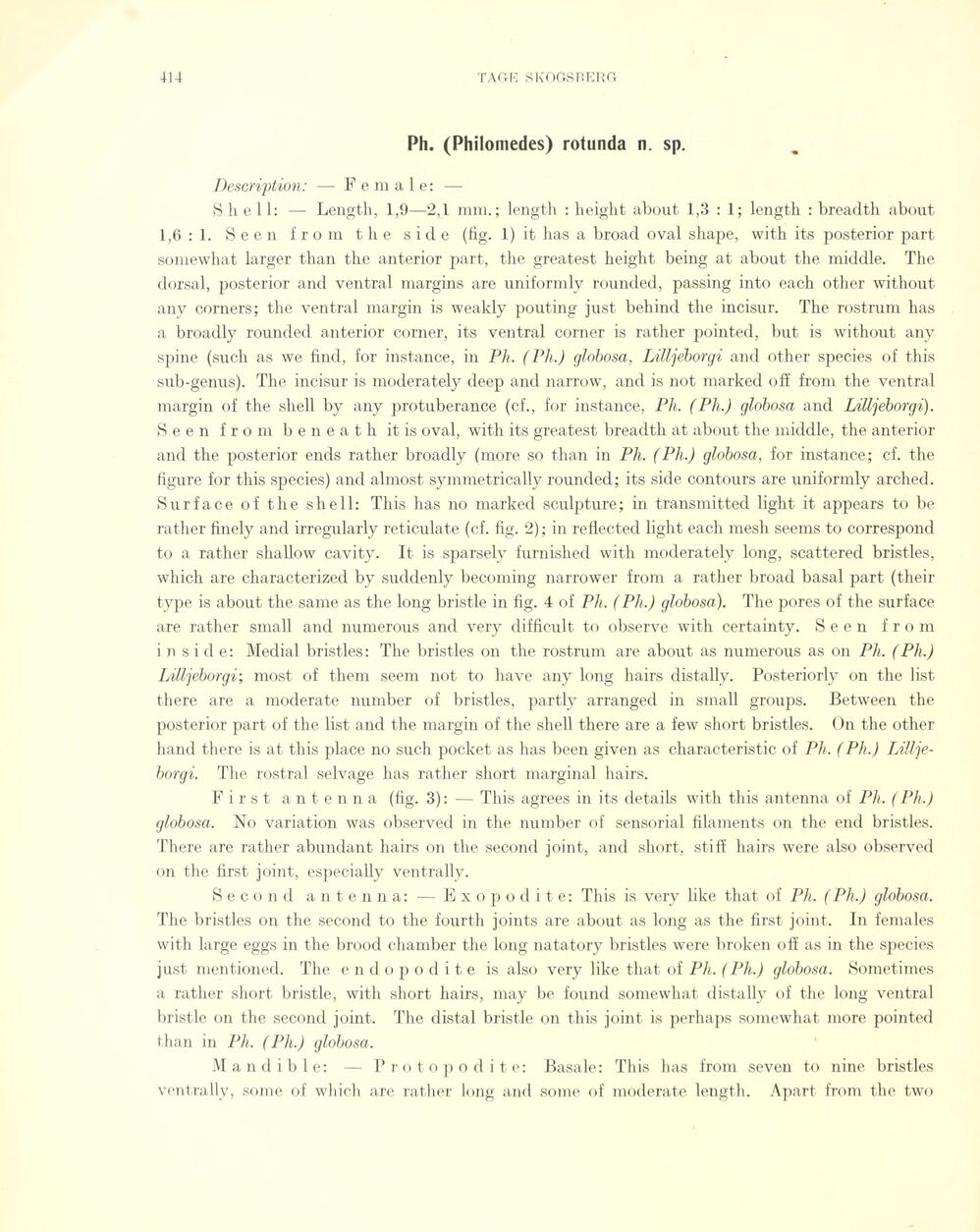
Full resolution (JPEG) - On this page / på denna sida - Sidor ...

<< prev. page << föreg. sida << >> nästa sida >> next page >>
Below is the raw OCR text
from the above scanned image.
Do you see an error? Proofread the page now!
Här nedan syns maskintolkade texten från faksimilbilden ovan.
Ser du något fel? Korrekturläs sidan nu!
This page has never been proofread. / Denna sida har aldrig korrekturlästs.
Ph. (Philomedes) rotunda n. sp.
Description: — F e m a 1 e : —
Shell: — Length, 1,9—2,1 mm.; length : height about 1,3 : 1; lengtk : breadth about
1,6 : 1. Seen f r o in the side (fig. 1) it has a broad oval shape, with its posterior part
somewhat larger than the anterior part, the greatest height being at about the middle. The
dorsal, posterior and ventral margins are uniformly rounded, passing into each other without
any corners; the ventral margin is weakly pouting just behind the in cisur. The rostrum has
a broadly rounded anterior corner, its ventral corner is rather pointed, but is without any
spine (such as we find, for instance, in Ph. (Ph.) globosa, Lilljeborgi and other species of this
sub-genus). The incisur is moderately deep and narrow, and is not marked off from the ventral
margin of the shell by any protubérance (cf., for instance, Ph. (Pli.) globosa and Lilljeborgi).
Seen from beneath itis oval, with its greatest breadth at about the middle, the anterior
and the posterior ends rather broadly (more so than in Ph. (Ph.) globosa, for instance; cf. the
figure for this species) and almost symmetrically rounded; its side contours are uniformly arched.
Surface of the shell: This has no marked sculpture; in transmitted light it appears to be
rather finely and irregularly reticulate (cf. hg. 2); in reflected light each mesh seems to correspond
to a rather sliallow cavity. It is sparsely furnished with moderately long, scattered bristles,
whick are characterized by suddenly becoming narrower from a rather broad basal part (their
type is about the same as the long bristle in fig. 4 of Ph. (Ph.) globosa). The pores of the surface
are rather small and numerous and very difficult to observe with certainty. Seen from
inside: Medial bristles : The bristles on the rostrum are about as numerous as on Pli. ( Ph.)
Lilljeborgi; most of them seem not to have any long hairs distally. Posteriorly on the list
there are a moderate number of bristles, partly arranged in small groups. Between the
posterior part of the list and the margin of the shell there are a few short bristles. On the other
hånd there is at this place no such pocket as has been given as characteristic of Ph. (Pli.)
Lilljeborgi. The rostral selvage has rather short marginal hairs.
First antenna (fig. 3) : — This agrees in its details with this antenna of Ph. ( Ph.)
globosa. No variation was observed in the number of sensorial filaments on the end bristles.
There are rather abundant hairs on the second joint, and short, sti ff hairs were also observed
on the first joint, especially ventrally.
Second antenna: — Exopodite: This is very like that of Pli. (Ph.) globosa.
The bristles on the second to the fourth joints are about as long as the first joint. In females
with large eggs in the brood chamber the long natatory bristles were broken ofï as in the species
just mentioned. The endopodite is also very like that of Pli. (Pli.) globosa. Sometimes
a rather short bristle, with short hairs, may be found somewhat distally of the long ventral
bristle on the second joint. The distal bristle on this joint is perhaps somewhat more pointed
than in Ph. (Ph.) globosa.
Mandible: — Pro topo dite: Basale: This has from seven to nine bristles
ventrally, some of which are rather long and some of moderate length. Apart from the two
<< prev. page << föreg. sida << >> nästa sida >> next page >>